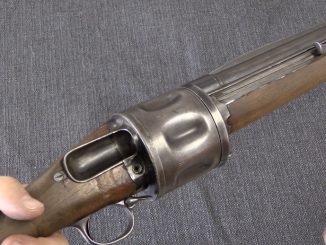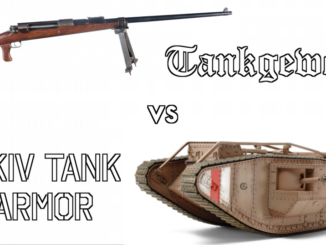Between the world wars, the Walther company designed and marketed a short recoil, toggle-locked 12 gauge shotgun for sporting use. It was patented by the Walther brothers, but actually manufactured by the Deutsche-Werke consortium, which was organized by the German government to employ German workers and export guns for much-needed foreign hard currency (they also made the Ortgies pistols).
The Walther shotgun was not particularly successful though, with only about 5700 made over about a 10-year period in the 1920s. I suspect the problem was as simple as the excessive recoil generated by the action. As I discovered shooting this example, it kicks substantially more than other comparable semiauto shotguns, and was really quite unpleasant to shoot. I cannot blame potential customers for choosing different guns (like, for example, the Browning Auto-5) that would have been available at the time.
Thanks to H. in Sweden for letting me shoot this quite uncommon shotgun!




Im slowly learning more and more about the types of semi auto action which I previoisly had no clue about, so thanks!
Regarding untypical solutions, does anyone having informations about Scotii anitcarro cal. 8-mm? Photos of sample:
https://raigap.livejournal.com/292235.html
so far only I know it was Italian WW2-era AT rifle chambered for specially designed cartridge (see 3rd photo from top in link), overall length 1475 mm, barrel length 874 mm, overall mass 8,5 kg. It was self-loading? If so which principle of operation it used? Why it do not have monopod or bipod? How big was magazine capacity?
If it was designed by Alfred Scotti, it was almost certainly gas-operated. His 9mm pistol was a rotating-barrel lock with gas delay, rather like a cross between the Steyr 1912 and the later Steyr GB series. Scotti used gas operation in virtually everything he designed. From the looks of this one, I’d suspect a gas-piston assembly under the barrel, similar to a Browning or Hotchkiss system.
cheers
eon
I know about Isotta Fraschini machine gun designed by Scotti.
In English it is described here: https://www.ibiblio.org/hyperwar/USN/ref/MG/I/MG-4.html in Chapter 27. This described claim that Scotti design are retared blow-back NOT gas-operated or to cite:
this action was undoubtedly retarded blow-back
Some more diagrams are available here:
http://www.airwar.ru/weapon/guns/scotti127.html
(near end, click on image to enlarge)
is: “(…)described(…)”
should be: “(…)description(…)”
Further search show that text I citied must be hoax, as system Scotti machine gun is indeed is gas operated.
Here: http://www.germanluftwaffe.com/archiv/Dokumente/ABC/m/Maschinen%20Gewehre/Maschinengewehre%20der%20Luftwaffe.html you can get D(Luft)T 6903, Scotti Isotta Fraschini 12,7 mm MG Handbuch , September 1944 (it is PDF, near end)
which clearly says that:
(…)Das 12,7 mm-Flugzeug-MG ist ein Gasdrucklader.(…)
which ends all dispute (unless you can deliver document which contain phrase this supersede D(Luft)T 6903) with only one question remain open:
is Deutsch Gasdrucklader EXACTLY equal to English term gas-operated?
D;
According to Wikipedia, that is exactly what it means;
https://de.wikipedia.org/wiki/Gasdrucklader
(Translated from de.wikipedia entry in German.)
cheers
eon
Bolt Action, single prototype. Probably not even designed for the A/T role, but rather more for anti materiel role (Italy already had plenty of Solothurns around which, by the date of that prototype, had already shown their limit against tanks).
“cannot blame potential customers for choosing different guns (like, for example, the Browning Auto-5) that would have been available at the time.”
How much that Walther shotgun cost when introduced? How it did compare to others?
This likely cost plenty more than competitors, considering machine costs. Why not just include a recoil buffer?!
Sounds like 2.5″ ammo, which the gun is proofed for, should be used. It’s well known that shotgun ammo longer than the chamber is designed for shouldn’t be used in shorter chambered shotguns, and may explain the sharp recoil Ian experienced. The gun was almost certainly intended for paper shells w/ a roll crimp, and the star crimp of the 67mm shells extended into the bbl on firing, resulting in higher pressure.
You are correct and at lead of rational thinking. Yet, it is so simple to conceive.
My thoughts exactly. Given 80 years the forcing cone on the other gun Ian fired could have been modified. Are shotgun pressures enough to flatten primers? Another thing to look for is damage to the hull where it is squeezed between the shot and barrel.
Would the increased pressure in the chamber after firing alter the physics of recoil?
Higher resistance to pellets + wad stack = higher pressure in chamber. There might be small increase of force forward but this is outdone by force back (F = pressure x area).
It doesn’t matter if it’s a paper rolled shell, or a plastic star crimped shell, the lenght of the shell is meassured once they have been fired, and plastic shells have much thinner walls, so using a 67 mm plastic shell in a gun intended for 65 mm paper shells doesn’t increase preassure in the chamber.
US Patent number. 1481042 Fritz Walther and Georg Walther.
High barrel axis, seemingly unsufficient action buffers, Eh!… No surprise of violent recoil kick.
Related US Patents; 1457477, 1460807, 1481042…
I had no idea such a steam punk auto shotgun existed, so thanks once again to Forgotten Weapons.
In the past, I always used two inch 12 bore cartridges, loaded with one ounce of No. 7 shot. Maybe the old Walther would shoot better with this kinder load? My old Browning Auto 5 was very happy with them.
“such a steam punk auto shotgun existed”
See also Becker self-loading shotgun (16 gauge, capacity: 5)
https://silvercore.wordpress.com/2014/06/03/the-becker-semi-auto-revolving-shotgun-silvercore-firearms-training-bc/
Good thing that this didn’t become a German political police gun… “This is a raid! Dead or alive, you’re coming with me!”
“Go away, you crazy cops!!”